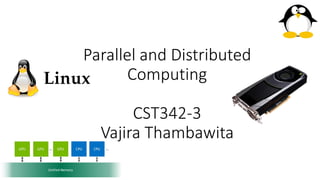
Lecture 1 introduction to parallel and distributed computing
- 1. Parallel and Distributed Computing CST342-3 Vajira Thambawita
- 2. Learning Outcomes At the end of the course, the students will be able to • - define Parallel Algorithms • - recognize parallel speedup and performance analysis • - identify task decomposition techniques • - perform Parallel Programming • - apply acceleration strategies for algorithms
- 3. Contents • Sequential Computing, History of Parallel Computation, Flynn’s Taxonomy, Process, threads, Pipeline, parallel models, Shared Memory UMA,NUMA, CCUMA, Ring ,Mesh , Hypercube topologies, Cost and Complexity analysis of the interconnection networks, Task Partition , Data Decomposition, Task Mapping, Tasks and Decomposition , Processes and Mapping ,Processes Versus Processors, Granularity, processing, elements, Speedup , Efficiency , overhead, Practical ,Introduction to Pthered library, CUDA program , MPICH, Introduction to Distributed Computing, Centralized System , Comparison , mini Computer ,Workstation models, Process pool , analysis, Distributed OS, Remote procedure call ,RPC, Sun RPC, Distributed Resource Management, Fault Tolerance
- 4. References • Ananth,G, Anshul,G, Karypis,G and Kumar,V, 2003, Introduction to Parallel Computing , 2nd Edition , Addison Wesley Optional References: • CUDA Toolkit Documentation • Introduction to Parallel Computing, Second Edition By Ananth Grama, Anshul Gupta, George Karypis, Vipin Kumar • Programming on Parallel Machines, Norm Matloff • Introduction to High Performance Computing for Scientists and Engineers, Georg Hager, Gerhard Wellein
- 5. Evaluation • Continuous Assessment: • 60% - Lab assignments, Tutorials, Quizzes, • End Semester Examination: • 40% - 2hrs or 3hrs paper
- 6. Knowledge • Data structures and algorithms • C programming
- 8. Four decades of computing • Batch Era • Time sharing Era • Desktop Era • Network Era
- 9. Batch era • Batch processing • Is execution of a series of programs on a computer without manual intervention • The term originated in the days when users entered programs on punch cards
- 10. Time-sharing Era • time-sharing is the sharing of a computing resource among many users by means of multiprogramming and multi-tasking • Developing a system that supported multiple users at the same time
- 11. Desktop Era • Personal Computers (PCs) • With WAN
- 12. Network Era • Systems with: • Shared memory • Distributed memory • Example for parallel computers: Intel iPSC, nCUBE
- 13. FLYNN's taxonomy of computer architecture Two types of information flow into processor: Instructions Data what are instructions and data?
- 14. FLYNN's taxonomy of computer architecture 1. single-instruction single-data streams (SISD) 2. single-instruction multiple-data streams (SIMD) 3. multiple-instruction single-data streams (MISD) 4. multiple-instruction multiple-data streams (MIMD)
- 17. Parallel Computers • all stand-alone computers today are parallel from a hardware perspective
- 18. Parallel Computers • Networks connect multiple stand-alone computers (nodes) to make larger parallel computer clusters.
- 19. Why Use Parallel Computing? • SAVE TIME AND/OR MONEY:
- 20. Why Use Parallel Computing? • SOLVE LARGER / MORE COMPLEX PROBLEMS Grand Challenge Problems ?
- 21. Why Use Parallel Computing? • PROVIDE CONCURRENCY
- 22. Why Use Parallel Computing? • TAKE ADVANTAGE OF NON-LOCAL RESOURCES:
- 23. Why Use Parallel Computing? • MAKE BETTER USE OF UNDERLYING PARALLEL HARDWARE • Modern computers, even laptops, are parallel in architecture with multiple processors/cores
- 24. BACK to Flynn's Classical Taxonomy
- 25. Single Instruction Single Data (SISD) • A serial (non-parallel) computer • This is the oldest type of computer UNIVAC1 IBM 360 CRAY1 CDC 7600 PDP1
- 26. Single Instruction Multiple Data (SIMD) ILLIAC IV MasPar Cray X-MP Cray Y-MP Cell Processor (GPU)
- 27. Multiple Instruction Single Data The Space Shuttle flight control computers
- 28. Multiple Instruction Multiple Data (MIMD) IBM POWER5 HP/Compaq Alphaserver Intel IA32 AMD Opteron
- 29. What are we going to learn?
- 30. Shared Memory System • A shared memory system typically accomplishes interprocessor coordination through a global memory shared by all processors. • Ex: Server systems, GPGPU
- 31. Message Passing System (Distributed Memory) • This kind of systems typically combine the local memory and processor at each node of the interconnection network • There is no global memory • Use message passing technique to move data from one local memory to another
- 32. Limits and Costs of Parallel Programming • Amdahl's Law: Amdahl's Law states that potential program speedup is defined by the fraction of code (P) that can be parallelized: 𝑆𝑝𝑒𝑒𝑑𝑢𝑝 = 1 1 − 𝑝 • If none of the code can be parallelized, P = 0 and the speedup = 1 (no speedup). • If all of the code is parallelized, P = 1 and the speedup is infinite (in theory).
- 33. Limits and Costs of Parallel Programming • If 50% of the code can be parallelized, maximum speedup = 2, meaning the code will run twice as fast.
- 34. Limits and Costs of Parallel Programming • Introducing the number of processors performing the parallel fraction of work, the relationship can be modeled by: 𝑠𝑝𝑒𝑒𝑑𝑢𝑝 = 1 𝑃 𝑁 + 𝑆 • where P = parallel fraction, N = number of processors and S = serial fraction
- 35. Limits and Costs of Parallel Programming
- 36. Next • Parallel Computer Memory Architectures
